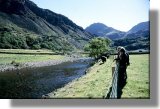|
 "Rivers usually flow through the most beautiful and interesting parts of a country. Upon the banks of Rivers stands the embattled fortress; and there, embosomed in wood, is discovered the venerable ruin of the no less stately edifice consecrated to religious retirement. The palace of the nobleman, the villa of the merchant, the proud metropolis, and the lowly village, alike prefer the margin of the stream, and the approach of the larger Rivers towards the sea, is enlivened with the white sails of numerous vessels laden with the produce of our own, or of distant climes. Rivers, as they frequently form the boundaries of states, furnish the historian with records of the bloody conflicts of contending armies, and of the political consequences of those sanguinary struggles. The history of Rivers, therefore, affords the opportunity of recording most of the leading events in the history of the kingdoms through which they flow; and of describing the prominent features of the country fertilized by their streams." "Rivers usually flow through the most beautiful and interesting parts of a country. Upon the banks of Rivers stands the embattled fortress; and there, embosomed in wood, is discovered the venerable ruin of the no less stately edifice consecrated to religious retirement. The palace of the nobleman, the villa of the merchant, the proud metropolis, and the lowly village, alike prefer the margin of the stream, and the approach of the larger Rivers towards the sea, is enlivened with the white sails of numerous vessels laden with the produce of our own, or of distant climes. Rivers, as they frequently form the boundaries of states, furnish the historian with records of the bloody conflicts of contending armies, and of the political consequences of those sanguinary struggles. The history of Rivers, therefore, affords the opportunity of recording most of the leading events in the history of the kingdoms through which they flow; and of describing the prominent features of the country fertilized by their streams."
John George Woods FSA (1813)
The Principal Rivers of Wales Illustrated; a series of views from the source of each river to its mouth. Accompanied by descriptions, historical, topographical and picturesque. Printed for the author by T. Bensley, Bolt Court, Fleet Street, London.
Past
 Rivers of ice were the first sculptors of the Welsh landscape, carving out valleys as they advanced and depositing sediment burdens as they retreated. Our river systems were finally revealed after the last Ice Age when they had to adjust to changes in sea level and land mass movement. As the vast weight of ice melted sea level rose causing estuaries to move upstream, and the flowing water cut into the rebounding land surface. Rivers continue to evolve through time and space in response to changes in the environment. Fast flowing and relatively straight mountain streams give way to lower energy meandering reaches, with sediments being eroded and deposited enroute. Rivers of ice were the first sculptors of the Welsh landscape, carving out valleys as they advanced and depositing sediment burdens as they retreated. Our river systems were finally revealed after the last Ice Age when they had to adjust to changes in sea level and land mass movement. As the vast weight of ice melted sea level rose causing estuaries to move upstream, and the flowing water cut into the rebounding land surface. Rivers continue to evolve through time and space in response to changes in the environment. Fast flowing and relatively straight mountain streams give way to lower energy meandering reaches, with sediments being eroded and deposited enroute.
 Every year hundreds of geography students come to view the glacial reminders and the still active riverine processes. It is also fun for them to imagine the megafauna such as Aurochsen, wild boar, Elk and other deer which were attracted to these early rivers for drinking, grazing or wallowing. While the activities of these animals added to the habitat diversity of the wider floodplain, the beavers’ tree felling activity opened up areas next to the channel, and their dam building created slow flowing pools attractive to other wildlife, such as fishes and birds. Every year hundreds of geography students come to view the glacial reminders and the still active riverine processes. It is also fun for them to imagine the megafauna such as Aurochsen, wild boar, Elk and other deer which were attracted to these early rivers for drinking, grazing or wallowing. While the activities of these animals added to the habitat diversity of the wider floodplain, the beavers’ tree felling activity opened up areas next to the channel, and their dam building created slow flowing pools attractive to other wildlife, such as fishes and birds.
The development of Welsh society and the evolution of its distinctive landscapes are intricately interwoven with the river systems of Wales. The ancient Celts worshipped rivers and cast offerings into them as they were thought to be portals to the afterlife. Evidence of early farming, tree felling and mining is preserved in thicker layers of sediment eroded from the land surface and deposited in valley bottoms. Rivers demarcated the boundaries of tribal lands and there was competition for hunting and fishing, with the design of the coracle ideal for rocky, shallow waters. Early industrial entrepreneurs used Welsh rivers as a hydro-power source, transport route for slate, and waste disposal facility for coal cinders and ash. Some political historians believe the protests surrounding the flooding of the Tryweryn River Valley, North Wales, to create a water supply for Liverpool in the 1950’s, provided the spark for the modern, independent, political identity of Wales.
Read more in The Rivers of Wales
|